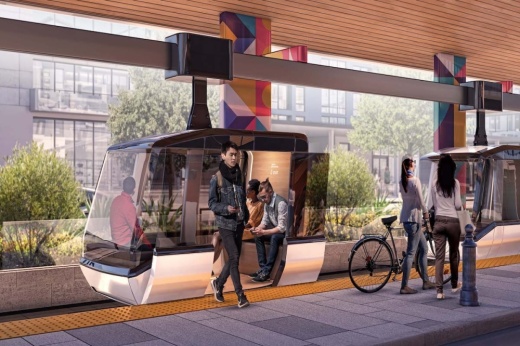Plano City Council opted to move forward with the application for the system developed by Swyft Cities during its March 21 meeting. The application is part of a program by the North Central Texas Council of Governments that reviews emerging technologies designed to ease traffic congestion. In turn, companies that are approved for the program can solicit interest from local governments.
At this point, the plan is under study, and there is no commitment—financial or otherwise—by the city, but city staff will devote time to conduct a feasibility study for the gondolas, Plano Transportation Engineering Manager Brian Shewski said.
Shewski said the city is considering a 2-mile area for a starter program that would include a loop around Legacy West and Legacy Town Center North.
If the project moves forward, Swyft Cities’ gondolas would be part of a fee-based aerial transit system that runs on a cable system. A phone app is used for scheduling and payments, and each gondola vehicle can transport two to four people.
“I’m absolutely in favor of this,” Council Member Anthony Ricciardelli said. “I think that’s a great deal to get in on the front of something that if it does work out could really help traffic in the city.”
Shewski added the gondolas could include a facial recognition system as a safety feature.
“The discussion of use of facial recognition software as part of a Swyft Cities system is very preliminary right now,” Swyft Cities spokesperson Leonard Lee said in an email response. "Currently, we're focused on evaluating potential sites for the first system in the Metroplex. At last week's City Council meeting, the city of Plano announced its intention to submit one or more sites for consideration."
Other cities may also submit applications before the NCTCOG’s April 10 submission deadline, Lee said. After that, Swyft Cities will work with the cities and the NCTCOG to make a final site selection.
Once the site is determined, further details, such as specific safety and security needs along with the best solutions, will be discussed, Lee said.
“Using facial recognition to restrict access in and out of corporate campuses is one potential application, but it will be about finding the best solution depending on what the layout of the final route will be and the specific needs of the riders,” Lee said.
Lee added the gondola system would include other “smart features,” such as an app to request a vehicle.
“You can use an app to request a vehicle, and it will be waiting for you at your station,” Lee said. “You board the vehicle, and it will take you directly to your destination nonstop with no intermediate stops along the way. Another ‘smart feature’ is that unlike traditional gondolas, the vehicles are self-propelled along fixed cables and independently select the best route, avoiding congestion or delays.”
There are also environmental advantages, Lee said.
“Swyft Cities vehicles emit zero emissions and use less energy than other forms of transportation,” Lee said. “In addition, by removing cars from the roads, Swyft Cities reduces the need for car infrastructure, such as parking and roads, which also contribute to greenhouse gases.”
The entire presentation from the March 21 council meeting is available online.
The NCTCOG’s program has evaluated and highlighted three transit technology companies—TransPod, JPod and Swyft Cities—for gondolas.
Plano has held discussions with JPod and is now considering Swyft Cities.




